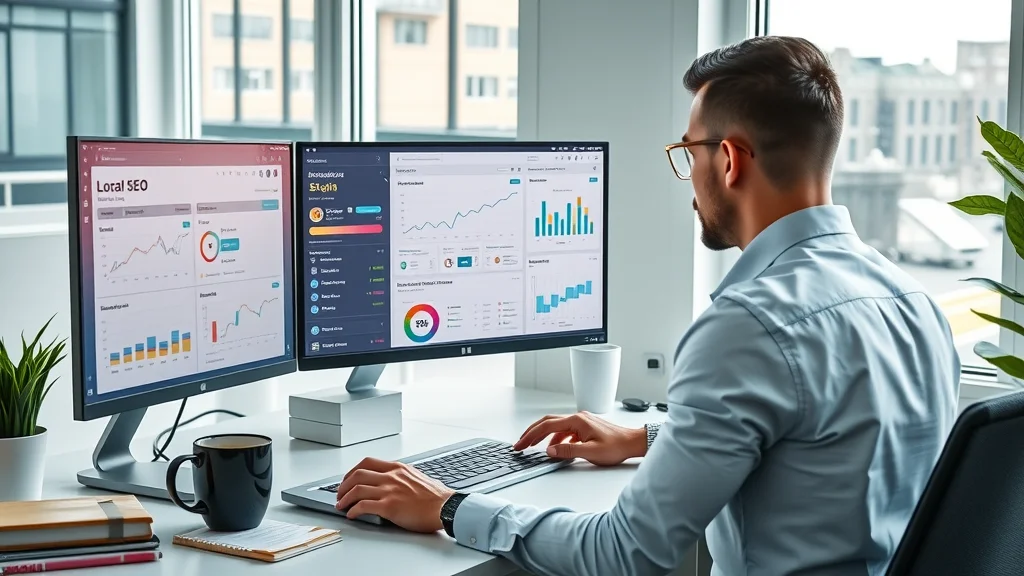Did you know that AI-powered tools like ChatGPT are now shaping how nearly one in three consumers discover local businesses online? If your business isn’t keeping up, you’re already letting potential customers slip away. In this guide, we’ll walk you through how improving local search with ChatGPT is transforming local SEO—and how you can get ahead before the competition catches on.

Why Improving Local Search with ChatGPT Matters for Local SEO
The way customers find local businesses is changing fast. No longer do people only rely on traditional search engines like Google or Bing. Today, AI-powered search—especially through solutions like ChatGPT search—can return tailored recommendations and nearby options with stunning accuracy. For business owners, improving local search with ChatGPT means being more visible when it matters most.
Leveraging AI search tools enhances traditional local SEO, tapping into new algorithms that factor in not only keywords, but also business info, customer engagement, and structured data such as schema markup. As more users turn to conversational AI for local recommendations, your business profile's presence in these AI searches can make or break your search result visibility. For small businesses, even minor tweaks—like maintaining NAP consistency and updating your Google Business Profile—can be the game-changer you need to stay competitive in your neighborhood or city.
As you refine your local SEO approach, it's helpful to see how real businesses leverage these strategies for tangible results. For example, the recent Burton House refinance in Beverly Hills demonstrates how a strong local business profile and community presence can attract significant investment and attention within a competitive market.
What You’ll Learn About Improving Local Search with ChatGPT
- The fundamentals of local SEO and local search in the ChatGPT era
- How optimizing local business profiles unlocks better search results
- Actionable strategies to enhance your local business presence using AI search tools
- How to leverage schema markup and business profile updates for local search results
- Expert tips for small businesses to make the most of ChatGPT search capabilities
Understanding Local Search: The Basics for Local Businesses
- What is local search and how does it differ from traditional SEO?
- The role of search results for local businesses
- Overview of Google Business Profile, Bing Places, and places profile management
- The impact of search result optimization on local businesses

At its core, local search helps potential customers find businesses, services, or products within their geographic area. Unlike broader SEO, it focuses on connecting local intent with relevant businesses. When someone looks for “best pizza shop near me,” local search ensures that the right local businesses appear in search results. Optimizing your Google Business Profile, Bing Places, or other places profiles is critical: these platforms feed accurate business info, location, hours, and reviews directly to search engines—including ChatGPT-powered ones.
Effective local SEO involves keeping your business details up to date, collecting reviews, using schema markup for clarity, and ensuring consistency across all platforms. When managed well, this boosts your business listing’s visibility not only in traditional search engine results but also in AI-driven searches where context and conversational engagement now play essential roles.
How ChatGPT Search Is Changing Local Search Results
"According to recent industry reports, AI-driven search engines now influence nearly 32% of local business discovery online." – Industry Analyst
The emergence of ChatGPT search represents a significant shift in how people find and interact with local businesses. Instead of scrolling through endless blue links, users ask AI tools naturally phrased questions, receiving tailored search results that combine local context, recent reviews, business information, and even personalized preferences. For example, asking ChatGPT, “Where can I find a family-friendly Italian restaurant open now?” can pinpoint relevant businesses with open hours and great reviews.
AI search engines evaluate business profiles differently: it’s not just about keywords anymore. ChatGPT search considers factors like schema markup, NAP consistency, customer engagement, and how recently a business listing was updated. By ensuring your profile is optimized and active, you’re more likely to feature in both traditional search results and next-gen conversational searches. With nearly a third of discovery now happening this way, improving local search with ChatGPT is no longer optional for business growth.
Step-by-Step Guide: Improving Local Search with ChatGPT
- Claim and optimize your Google Business Profile and Bing Places Profile
- Ensure your business info (name, address, phone number) is accurate and consistent
- Incorporate strong schema markup relevant to your local business
- Use schema markup to help search engines identify your physical location, services, opening hours, and contact methods
- Implement location-based keywords in business profile descriptions
- Strategically add area names and service keywords to enhance relevance in local search and chatgpt search
- Encourage and manage high-quality customer reviews
- Request feedback from satisfied customers and respond promptly to maintain engagement
- Update business profile details frequently to enhance chatgpt search result accuracy
- Keep your hours, services, and promotions current for maximum visibility
- Monitor and analyze your local search results for continual improvement
- Use ai tools, analytics platforms, and manual searches to spot trends and opportunities

Optimizing Your Local Business Profile for AI Search Results
- Updating business name, address, phone number (NAP) consistency across local business directories
- Crafting compelling business profile descriptions with main and related keywords (local seo, chatgpt search, business profile, Google Business, schema markup)
- Using high-quality images and videos to increase profile engagement
- Leveraging reviews and Q&A to boost local search optimization
NAP consistency—your business name, address, and phone number—remains a cornerstone of local SEO and AI-driven search. Mismatched NAP details across directories can hurt your credibility and muddle search results, especially as ChatGPT search cross-references data sources to verify business information. Double-check your Google Business Profile, Bing Places, and other listings regularly to ensure flawless accuracy.
Go beyond the basics by refreshing your business profile description with targeted keywords like “local SEO,” “chatgpt search,” and service-specific phrases. A compelling, keyword-rich summary improves both traditional and AI search discoverability. Additionally, upload high-quality images and videos—profiles with engaging visuals often attract more clicks and longer dwell times, signaling to AI tools that your business is both active and trusted. Don’t forget to foster your Q&A section, as ChatGPT and other AI search engines increasingly surface user-generated queries and answers in local search results.
The Role of Schema Markup in Improving Local Search with ChatGPT

Structured data—schema markup—helps search engines and AI tools like ChatGPT understand critical details about your local business, including address, hours, services, and reviews. While traditional search engines rely on schema to power local business cards and panels, ChatGPT search actively parses this data to ensure accurate, contextually relevant search results.
Adding schema markup to your website and business listings can highlight you above competitors lacking this technical edge. Google’s and Bing’s business profiles offer native support for structured data, making it easy to integrate. Use JSON-LD format, and always verify your schema markup with Google’s Rich Results Test or Schema.org’s validator to avoid errors that could harm your visibility.
| Schema Type | Applies To | Key Benefit in ChatGPT Search |
|---|---|---|
| LocalBusiness | Any physical or service-based local business | Enables core NAP data display, improves chances of appearing in local search results |
| Restaurant | Food services, cafes, bars | Highlights menu, opening hours, reservation links to drive more foot traffic |
| MedicalBusiness | Clinics, dentists, healthcare providers | Pinpoints service specialties, location, availability for AI-driven recommendations |
| Store | Retail shops, outlets, specialty stores | Enhances product info, directs local buyers to in-stock deals and hours |
| Service | Repair, consulting, trades | Drives targeted queries with service categories and contact info for instant leads |
Using Reviews and Engagement to Boost Local Search Results
- How to request and manage reviews effectively
- Responding to reviews for better local SEO and local search visibility
- Examples of review-driven search result improvements

Reviews are a major ranking factor for both traditional and AI-driven local search. Actively requesting feedback from happy customers, whether in person or via email/SMS follow-ups, boosts not just your profile’s trust but also its likelihood of ranking higher in ChatGPT search and local recommendations. Make leaving a review easy by sharing direct profile links or displaying QR codes at checkout.
For better local SEO, consistently respond to reviews—even the critical ones—and thank customers for their input. Engage with the community, answer FAQs publicly, and use responses to clarify your strengths or update service details. Over time, frequent positive reviews can lead to featured placements (like “Best Rated” or “Local Favorite”) within search results, especially when paired with a high rating and prompt engagement.
How AI Search and ChatGPT Search Rank Local Business Listings
"Completeness of your local business profile directly impacts your visibility in ChatGPT-powered search results." – Local SEO Expert
AI search and ChatGPT search consider more than just keywords or generic optimization—they look at the completeness, accuracy, and freshness of your business listing. Profiles that display correct NAP, updated services, rich images, and regular reviews often get prioritized in search results. AI-driven algorithms use structured data, engagement metrics, and even linguistic cues from customer interactions to surface the most trustworthy and relevant local businesses.
To optimize your placement, keep business information updated across all directories, engage with questions and feedback regularly, and invest in frequent profile enhancements. Both Google Business Profile and Bing Places updates are indexed quickly by AI search platforms, which improves your chance of capturing high-intent users searching for your services in real time.
Local SEO vs. AI Search: Bridging Traditional and Next-Gen Strategies
- Standard local business directory optimization vs. schema-rich AI listing
- Keyword targeting for local search compared to contextual AI-driven results
- User intent mapping in search results
Traditional local SEO relies heavily on keyword placement and directory optimization. Business owners ensure their info is listed on Google My Business, Bing Places, and other directories—with the main goal of ranking higher in classic search engine results. However, ai search engines like ChatGPT interpret listings using more sophisticated algorithms. They parse structured data like schema markup, assess engagement signals, and respond to natural, conversational queries.
Bridging these strategies means maintaining strong traditional local SEO foundations—keyword optimization, business profile updates, customer reviews—while also embracing AI-first tactics. Focus on intent mapping, schema enhancements, and conversational cues in your listings. The integration of both methods ensures your local business remains discoverable across all search platforms—current and future.

Pro Tips: Maintaining a Competitive Edge in Local Search with ChatGPT
- Monitor new developments in chatgpt search and ai search capabilities
- A/B test changes in schema markup and business profile updates
- Engage with customers through multiple platforms for wider local search visibility
- Stay updated on Google Business Profile and Bing Places enhancements
To stay ahead, track new features and updates from AI-driven platforms like ChatGPT and traditional search engines. Experiment with A/B testing changes to your schema markup or business profile to find out which updates yield better search results. Don’t limit engagement to just one channel; use social media, local forums, review sites, and messaging apps to maximize visibility and customer reach. Finally, sign up for alerts from Google Business Profile and Bing Places to learn about new optimization options as soon as they roll out.
Top Tools for Improving Local Search with ChatGPT

| Tool | Main Function | Best For |
|---|---|---|
| BrightLocal | Local SEO audit, citation management, review monitoring | Comprehensive local business optimization |
| Google Business Profile Manager | Business profile updates, engagement tracking | Direct profile changes and review response |
| ChatGPT/AI Plugins | Conversational analysis, content planning | Testing visibility in AI search results |
| Merkle Schema Markup Generator | Create and validate local business schema | Fast schema implementation for non-coders |
| Yext | Directory data syncing, reputation management | NAP consistency across many platforms |
People Also Ask: Common Questions about Improving Local Search with ChatGPT
How to optimise for ChatGPT search?
To optimise for ChatGPT search, keep your business profile updated across directories like Google Business and Bing Places. Use location-based keywords, structure your data with schema markup, and encourage customer reviews. AI tools like ChatGPT favor profiles that are complete, consistent, and rich with recent engagement and informative Q&A sections.
How to optimize for local search?
The key to local search optimization is accuracy and engagement: make sure your NAP is correct everywhere, add high-quality images, select appropriate business categories, use local keywords in your descriptions, and actively respond to customer feedback. Optimize your website with schema markup and link it to your business profiles for maximum visibility in local and ChatGPT search results.

How do I force ChatGPT search to use high quality sources?
While you can't force ChatGPT to use specific sources, you can increase the likelihood it will reference your business by maintaining an authoritative and consistent online presence. Regularly update your business info, encourage external links from reputable sites, and use structured data to ensure your information is clear and credible for AI tools like ChatGPT.
How to effectively search on ChatGPT?
For best results, phrase your queries naturally (e.g., "Where is the best bakery near Main Street?"). The more specific your question, the more relevant the search results. ChatGPT leverages up-to-date data sources and structured business information, so businesses with optimized profiles and recent reviews are more likely to be recommended.
List of FAQs: Improving Local Search with ChatGPT
-
How often should I update my local business profile?
Update at least every few months—or whenever you change business info, add services, or receive new reviews for optimal search visibility. -
Do reviews really affect my local search results in ChatGPT?
Absolutely! Positive and recent reviews increase your trustworthiness and ranking in AI-powered local search results. -
What is the easiest schema markup to implement for local businesses?
TheLocalBusinessschema type is most straightforward, available via simple plug-ins and online generators. -
How do I get featured in ChatGPT’s local search results?
Keep your business profile complete, accurate, and packed with recent reviews and up-to-date schema markup. -
Can small businesses compete with large chains in AI search ranking?
Yes! Focusing on reviews, consistent profiles, and rich local content often helps small businesses outrank larger competitors in local AI searches.
Key Takeaways for Small Businesses: Improving Local Search with ChatGPT
- ChatGPT search is revolutionizing local SEO for local businesses.
- Local business profile optimization directly impacts AI-driven search result rankings.
- Schema markup and regular reviews boost your visibility in local search results.
- Consistency and engagement are critical for business profile performance in chatgpt search.
Ready to Grow Your Business? Contact Us Today at 818.716.2097
Take action now to get ahead with improving local search using ChatGPT—small adjustments today can drive huge results tomorrow!
As you continue to refine your local search strategy with AI-driven tools, remember that staying informed about broader trends and success stories can inspire your next move. Exploring how businesses like Burton House have leveraged their local presence to secure major opportunities can offer valuable lessons for your own growth journey. If you're eager to discover more ways to elevate your business profile and attract attention in your community, take a look at how strategic local positioning led to a $55 million refinance in Beverly Hills. Let these insights fuel your ambition and help you unlock new possibilities in the evolving landscape of local SEO.
Sources
- https://searchengineland.com
- https://developers.google.com/search/docs/appearance/structured-data/local-business
- https://moz.com/learn/seo/local
- https://blog.hubspot.com/marketing/local-seo-guide
To enhance your understanding of how ChatGPT is transforming local search and to implement effective strategies for your business, consider exploring the following resources: “How ChatGPT Is Impacting Local Search Results”: This article delves into the nuances of ChatGPT’s approach to local search, highlighting key differences from traditional search engines and offering insights into how businesses can adapt to these changes. (earnseo.com) “Can ChatGPT Be Used in Local SEO? Boost Visibility Now”: This piece provides practical steps for businesses to leverage ChatGPT in their local SEO efforts, emphasizing the importance of consistent online presence and the role of Bing Places listings in enhancing visibility. (ollyolly.com) By integrating the strategies discussed in these articles, you can effectively optimize your local search presence in the era of AI-driven search engines.
 Add Row
Add Row  Add
Add 




Write A Comment